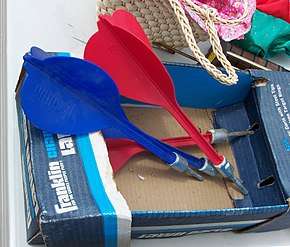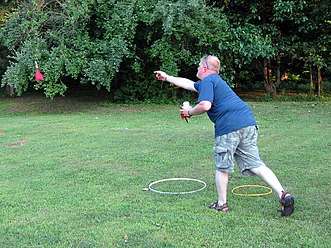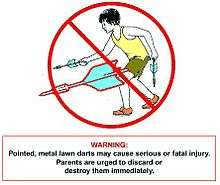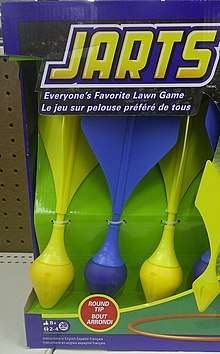Lawn darts
Lawn darts (also known as Javelin darts, jarts, lawn jarts or yard darts) is a lawn game for two players or teams. A lawn dart set usually includes four large darts and two targets. The game play and objective are similar to those of both horseshoes and darts. The darts are typically 12 inches (30 cm) long with a weighted metal or plastic tip on one end and three plastic fins on a rod at the other end. The darts are intended to be tossed underhand toward a horizontal ground target, where the weighted end hits first and sticks into the ground. The target is typically a plastic ring, and landing anywhere within the ring scores a point. After many injuries and deaths caused by lawn darts, they have been banned in the United States and Canada.


Rules

The game may be played with standard or Handly Cup rules.[1] Either variation can be played one-on-one or by teams of two. In the team versions, the players stand with one member from each team at each end (they should be sure to stand well back when the other side is throwing) and toss the darts to a target about 35 feet (11 m) away (with variation based on the players' skill and the location of the game).
In standard game play, points are scored when a dart lands in the target area. Usually if players from both teams land darts in the target, the scores cancel each other; for example, if Team A lands two darts in the target area and Team B lands one, Team A would get one point and Team B would get zero. Some versions of lawn darts include a smaller bullseye ring for additional points.
With the Handly Cup style, scores are based on darts in the ring plus darts closer to the ring than any of the opposing team's darts. Darts landing inside the ring, or "ringers", are worth three points each, and can be canceled by darts thrown by opponents that also land in the ring. Any dart that is closer to, but outside, the ring than any other dart thrown by the opposing team is worth one point. This means that if neither team managed to place a dart into the ring, but Team A landed two darts closer than did any of Team B's darts, Team A would score two points. If Team A landed one dart in the ring, and one dart closer than any of Team B's darts, Team A would score four points. If both teams land darts in the ring, it is impossible for a dart outside the ring to score any points, as it is farther from the ring than the opposing team's dart that is inside. If Team A and Team B each land a dart inside the ring, and Team A also lands a dart outside the ring but closer to the ring than Team B's other dart, neither team would score any points for the round. Handly Cup style matches are typically played by teams of two, with the pairs alternating until one team's total score is 21 or more. For a point to count, the dart must stick into the ground.
Safety and bans in the U.S. and Canada

In October 1970, the U.S. Food and Drug Administration (FDA) requested that R. B. Jarts, Inc. add labels to its line of lawn darts noting that they were for use by adults only.[2] In December 1970, the FDA required all lawn darts to bear the label "WARNING: Not a toy for use by children. May cause serious or fatal injury. Read instructions carefully. Keep out of reach of children."[3][2] It also required that lawn darts could not be marketed as a toy for children or be sold in toy stores or toy departments.[2]
In November 1970, Consumers Union and the Children's Foundation petitioned the US Secretary of Health, Education and Welfare to use emergency provisions of the Child Protection and Toy Safety Act of 1969 to ban outright "outdoor games with 13‐inch pointed darts weighing more than five ounces each."[4] On December 18, 1970, a federal judge failed to uphold the proposed ban.[5][2]
In April 1987, seven-year-old Michelle Snow was killed by a lawn dart thrown by one of her brothers' playmates in the backyard of their home in Riverside, California. The darts had been purchased as part of a set of several different lawn games and were stored in the garage, never having been played before the incident occurred. Snow's father David began to advocate for a ban on lawn darts, claiming that there was no way to keep children from accessing lawn darts short of a full ban.[6][7]
Partly as a result of David Snow's lobbying, on December 19, 1988 the U.S. Consumer Product Safety Commission introduced an outright ban on lawn darts in the U.S.[8] In the previous eight years, 6,100 Americans had visited hospital emergency rooms as the result of lawn-dart accidents. Of that total, 81% were 15 or younger, and half were 10 or younger. During the week when the commission voted to ban the product, an 11-year-old girl in Tennessee was hit by a lawn dart and fell into a coma.[6]

In Canada, lawn darts caused at least 55 serious injuries.[9] They were banned for sale in the country from July 1989.[10][11] The sale of second-hand lawn darts is also illegal under the Hazardous Products Act.[12] Since then, alternatives have surfaced that are available for sale in Canada and are made of plastic.
It is possible to import lawn-dart parts, such as plastic flights, metal bodies and steel spigots, into the U.S. and Canada, as well as complete sets of replacement parts to repair damaged lawn darts. However, fully assembled individual darts, sets and kits are banned from entry by U.S. and Canadian customs authorities.
As of 2020, a modified, safer version of lawn darts with a modified blunt-tip design may be purchased in the United States.
Similar games
- Crown darts is a variation using the same equipment in which the darts are tossed toward a target dart instead of a plastic ring target.
See also
References
- "Lawn Dart Games - Standard & Handly Cup Style". Darts & Piks. Retrieved 2020-07-16.
- "R. B. Jarts, Inc., Petitioner, v. Elliot L. Richardson, Secretary of the Department of Health, Education and Welfare and Charles C. Edwards, Commissioner of the Food and Drug Administration, Respondents, 438 F.2d 846 (2d Cir. 1971)". Justia Law. Retrieved 6 June 2020.
- The Code of Federal Regulations of the United States of America. U.S. Government Printing Office. 1971. Retrieved 6 June 2020.
- Morris, John D. (19 November 1970). "Consumer Groups Seeking Ban on 8 Toys". The New York Times. Retrieved 6 June 2020.
- "U.S. Judge Refuses To Enjoin the Sale Of 9 Disputed Toys". The New York Times. 11 December 1970. p. 61. Retrieved 6 June 2020.
- Soniak, Matt. How one dad got lawn darts banned. Mental Floss, 2012-07-12.
- "CPSC Votes Lawn Dart Ban". CPSC.gov. 25 May 1988. Retrieved 22 February 2017.
- "Lawn Darts Are Banned and Should Be Destroyed". U.S. Consumer Product Safety Commission. 1997-05-15. Archived from the original on 2010-12-16. Retrieved 2011-01-25.
Pointed lawn darts, intended for use in an outdoor game, have been responsible for the deaths of three children. The most recent injury occurred last week in Elkhart, Ind., when a 7-year-old boy suffered a brain injury after a lawn dart pierced his skull.
- "June 13, 1989: Lawn darts tossed from store shelves". Canadian Broadcasting Corporation. 15 June 2017.
- "Canada Consumer Product Safety Act Quick Reference Guide". Health Canada. Government of Canada. Retrieved 16 June 2017.
- "Health Canada has warnings for garage salers". Canadian Broadcasting Corporation. 15 May 2012.
- "Health Canada reminds Canadians about the safety of items sold at garage sales". Recalls and safety alerts. Government of Canada. 7 May 2004.